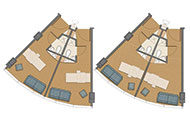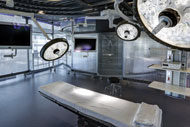Can the design of a hospital room keep patients safer by reducing the risk of falls?
That’s what Debajyoti Pati, professor of environmental design in the College of Human Sciences, Texas Tech University, Lubbock, is working to find out. He is leading a research team in a multiphase project to determine if patient room design impacts safety and, if so, how to improve it.
Pati started the first phase of research last year in collaboration with health care design firm HKS Architects, Dallas, and the falls committee of Covenant Health System, Lubbock.
Pati and his team began to identify physical design elements that contribute to patient falls by creating likely fall scenarios using industry data and experiences from health care providers. They created a space representing a typical hospital room and bathroom to make the study as realistic as possible.
Participants older than 70 were hooked up to motion-capture technology and wearing body harnesses to prevent injury interacted within the rooms the same way as regular patients. While they were stopped from falling, the motion-capture technology recorded their movements up to that point.
Researchers found that falls frequently happen as elderly people assumed four types of postures while interacting with their physical environments: pushing, pulling, turning and grabbing.
Design elements associated with these postures include bathroom configuration, bathroom door, toilet seat and grab bars, the toilet flush handle and obstructions along the path to the bathroom.
"One of the things we found was turning as a posture activity was associated highest with fall frequencies. Our challenge now is how we design a bathroom to reduce turns. We cannot eliminate all of them, but we have to reduce them as much as possible," he says.
IV design also is a major contributor to falls, he says. The combination of turning, pushing and pulling while managing the IV pole and not stepping on the base, especially while opening and closing a bathroom door, is a leading cause of patient falls, he adds.
“The IV pole design is faulty and even the clinicians say the industry needs to rethink how it is designed.” he says.
While the patient room the researchers created included minimal objects, they determined that even a chair, overbed table and trash can pose difficulties for the elderly to maneuver around.
Pati says the next phase of research will look at finding practical design solutions to increase patient safety. “We have started developing our own hypothesis about what could be solutions. We haven't gone to the innovation stage yet, but that is what we are starting right now,” he says.





